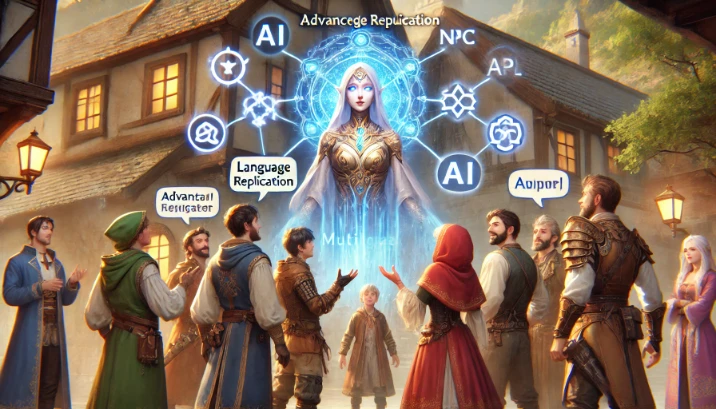How Can AI Accurately Replicate Human Language?
Replicating human language with high accuracy is not just about understanding words but also grasping context, emotions, and intent. AI that can interact naturally must integrate advanced techniques, including natural language processing (NLP), deep learning models, and contextual adaptation systems.
1. Utilizing Large Language Models (LLMs)
Models like GPT, BERT, and T5 have revolutionized how AI handles language. With billions of parameters, AI can:
- Generate more natural and contextually appropriate text.
- Understand nuanced meanings in various sentence structures.
- Adapt language style according to the audience or platform.
2. Context Adaptation and Emotion Understanding
Understanding words alone is not enough. AI must be able to:
- Detect emotions in text and adjust responses accordingly.
- Remember previous conversations to provide more relevant answers.
- Avoid misinterpretations caused by language ambiguity.
3. Fine-Tuning and Continuous Training
Language models must be continuously trained and updated with high-quality data. This includes:
- Training on diverse datasets to reduce biases.
- Evaluation and refinement through human feedback.
- Using transfer learning techniques for efficient adaptation to new languages.
4. Real-World Applications
To maximize its benefits, AI language replication must be applied in:
- Chatbots that efficiently handle customer service.
- Virtual assistants that understand user needs.
- More accurate automated translation systems.
Conclusion
Integrating AI for language replication is not just about mimicking words but truly understanding context, nuance, and emotions. With powerful language models, effective context adaptation, and continuous training, AI can interact with humans more naturally and accurately.
Curious About Implementation? Let’s Learn!
Imagine creating an AI-powered NPC in an RPG game that can understand and respond in multiple in-game languages. To achieve this, we will use an AI model to handle real-time conversations.
Preparation: Choosing an AI Model
Before we start coding, we need to choose the AI model that will power our NPC. Some of the best options include:
- GPT (Generative Pre-trained Transformer) – Ideal for generating natural and flexible responses.
- Rasa NLU – Provides better control over intent recognition and structured dialogues.
- Custom Model – A specially trained AI model using game-specific datasets for better immersion.
Step 1: Setting Up OpenAI API in Unity
Since we are using Unity as the game engine, we need a way to communicate with the AI model.
using UnityEngine;
using System.Collections;
using System.Collections.Generic;
using UnityEngine.Networking;
using Newtonsoft.Json;
public class AIChat : MonoBehaviour
{
private string apiUrl = "https://api.openai.com/v1/chat/completions";
private string apiKey = "YOUR_OPENAI_API_KEY";
public void SendMessageToAI(string userMessage)
{
StartCoroutine(SendRequest(userMessage));
}
IEnumerator SendRequest(string message)
{
var jsonData = new Dictionary<string, object>
{
{ "model", "gpt-3.5-turbo" },
{ "messages", new List<Dictionary<string, string>> {
new Dictionary<string, string> { { "role", "user" }, { "content", message } }
}},
{ "max_tokens", 100 }
};
string json = JsonConvert.SerializeObject(jsonData);
var request = new UnityWebRequest(apiUrl, "POST");
byte[] bodyRaw = System.Text.Encoding.UTF8.GetBytes(json);
request.uploadHandler = new UploadHandlerRaw(bodyRaw);
request.downloadHandler = new DownloadHandlerBuffer();
request.SetRequestHeader("Content-Type", "application/json");
request.SetRequestHeader("Authorization", "Bearer " + apiKey);
yield return request.SendWebRequest();
if (request.result == UnityWebRequest.Result.Success)
{
var response = JsonConvert.DeserializeObject<Dictionary<string, object>>(request.downloadHandler.text);
var choices = (List<object>)response["choices"];
var firstChoice = (Dictionary<string, object>)choices[0];
var messageData = (Dictionary<string, object>)firstChoice["message"];
Debug.Log("AI Response: " + messageData["content"]);
}
else
{
Debug.LogError("API Request Failed: " + request.error);
}
}
}
Step 2: Creating an Interactive NPC
The NPC in our game should be able to receive input from the player and respond with text generated by the AI.
using UnityEngine;
public class NPC : MonoBehaviour
{
public AIChat aiChat;
void Start()
{
aiChat = GetComponent<AIChat>();
}
void OnPlayerInteraction(string playerInput)
{
aiChat.SendMessageToAI(playerInput);
}
}
Step 3: Adding Multi-Language Support
We can implement automatic translation using an external API like Google Translate.
public void TranslateAndSend(string message, string targetLanguage)
{
string translatedMessage = TranslateMessage(message, targetLanguage);
SendMessageToAI(translatedMessage);
}
private string TranslateMessage(string message, string targetLanguage)
{
// Implement translation here (e.g., using Google Translate API)
return message; // Placeholder
}
Step 4: Optimizing Performance
To reduce API calls and improve efficiency, we can cache AI responses.
Dictionary<string, string> cachedResponses = new Dictionary<string, string>();
public void SendMessageToAI(string userMessage)
{
if (cachedResponses.ContainsKey(userMessage))
{
Debug.Log("Cached Response: " + cachedResponses[userMessage]);
return;
}
StartCoroutine(SendRequest(userMessage));
}
IEnumerator SendRequest(string message)
{
// (Same API request code as before)
cachedResponses[message] = responseText; // Store result in cache
}
Conclusion
By integrating AI into NPCs in RPG games, we can create more immersive and natural interactions. From selecting an AI model, implementing it in Unity, adding multilingual support, to optimizing performance—each step contributes to building a smarter and more engaging game world.
Now, don’t just read—dare to implement! Challenge the world, say “Hello World,” and embrace the madness. The game won’t build itself, so get coding!


 2:30 PM
2:30 PM








